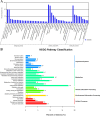A tissue-specific profile of miRNAs and their targets related to paeoniaflorin and monoterpenoids biosynthesis in Paeonia lactiflora Pall. by transcriptome, small RNAs and degradome sequencing
- PMID: 36701382
- PMCID: PMC9879538
- DOI: 10.1371/journal.pone.0279992
A tissue-specific profile of miRNAs and their targets related to paeoniaflorin and monoterpenoids biosynthesis in Paeonia lactiflora Pall. by transcriptome, small RNAs and degradome sequencing
Abstract
Paeonia lactiflora Pall. (Paeonia) has aroused many concerns due to its extensive medicinal value, in which monoterpene glucoside paeoniflorin and its derivatives are the active chemical components. However, little is known in the molecular mechanism of monoterpenoids biosynthesis, and the regulation network between small RNAs and mRNAs in monoterpenoids biosynthesis has not been investigated yet. Herein, we attempted to reveal the tissue-specific regulation network of miRNAs and their targets related to paeoniaflorin and monoterpenoids biosynthesis in Paeonia by combining mRNA and miRNA expression data with degradome analysis. In all, 289 miRNAs and 30177 unigenes were identified, of which nine miRNAs from seven miRNA families including miR396, miR393, miR835, miR1144, miR3638, miR5794 and miR9555 were verified as monoterpenoids biosynthesis-related miRNAs by degradome sequencing. Moreover, the co-expression network analysis showed that four monoterpenoids-regulating TFs, namely AP2, MYBC1, SPL12 and TCP2, were putatively regulated by five miRNAs including miR172, miR828, miR858, miR156 and miR319, respectively. The present study will improve our knowledge of the molecular mechanisms of the paeoniaflorin and monoterpenoids biosynthesis mediated by miRNA to a new level, and provide a valuable resource for further study on Paeonia.
Copyright: © 2023 Xu et al. This is an open access article distributed under the terms of the Creative Commons Attribution License, which permits unrestricted use, distribution, and reproduction in any medium, provided the original author and source are credited.
Conflict of interest statement
The authors have declared that no competing interests exist.
Figures













References
-
- Zhang X, Wang J, Li X. A study on the chemical constituents of Paeonia lactiflora Pall. J Shenyang Pharm Univ. 2001;18: 30–32.
-
- Tan JJ, Zhao QC, Yang L, Shang ZP, Du ZQ, Yan M. Chemical constituents in roots of Paeonia lactiflora. Chinese Tradit Herb Drugs. 2010;41: 1245–1248.
-
- Dong H, Liu Z, Song F, Yu Z, Li H, Liu S. Structural analysis of monoterpene glycosides extracted from Paeonia lactiflora Pall. using electrospray ionization Fourier transform ion cyclotron resonance mass spectrometry and high-performance liquid chromatography/electrospray ionization tandem mass. Rapid Commun Mass Spectrom An Int J Devoted to Rapid Dissem Up-to-the-Minute Res Mass Spectrom. 2007;21: 3193–3199. - PubMed
Publication types
MeSH terms
Substances
LinkOut - more resources
Full Text Sources
Research Materials

